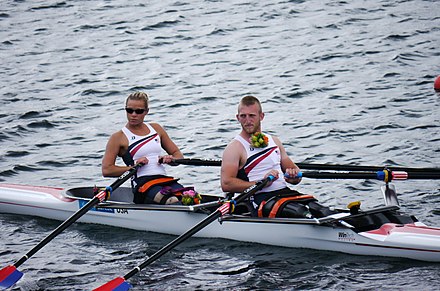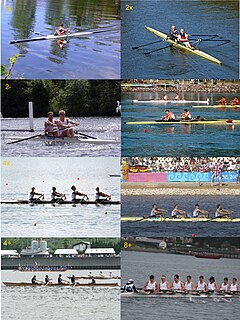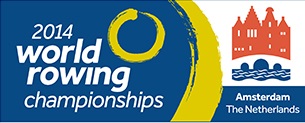
Adaptive rowing (or para-rowing) is a category of rowing race for those with physical, visual or intellectual disabilities.

Adaptive rowing (or para-rowing) is a category of rowing race for those with physical, visual or intellectual disabilities.
In 1913, rowing for individuals with disabilities was initiated by headmaster George Clifford Brown at Worcester College for the Blind in Great Britain. [1] Brown encouraged blind students to participate in particular sports in which they would be able to compete at an equal level to sighted players and do so without modifications. Other organizations dedicated to rehabilitating the blind, such as St. Dunstan's Hostel, started rowing clubs shortly afterwards in 1915. Competitive rowing with blind rowers first began in 1914 between Worcester College and the Old Boys in one race and Worcester College and Worcester Boy Scouts in another race the same year. [1]
In October 1945, veterans from the Army, Navy, and Marines blinded during WWII entered into the Navy Day Regatta on the Schuylkill River in Philadelphia. Some consider this event as what spawned the international interest of adaptive rowing. [1]
Under FISA rules there are three categories for adaptive rowers:
At FISA World Championships there are now 9 [2] boat events (standard nomenclature is used).
| Boat Type | Seat Count | Sex | Coxed | Class | FISA Notation | FISA World Championships | Paralympic Games |
|---|---|---|---|---|---|---|---|
| Scull | 1 | Men | Unspecified | PR1 | PR1 M1x | Yes | Yes |
| Scull | 1 | Women | Unspecified | PR1 | PR1 W1x | Yes | Yes |
| Scull | 1 | Men | Unspecified | PR2 | PR2 M1x | Yes | No |
| Scull | 1 | Women | Unspecified | PR2 | PR2 W1x | Yes | No |
| Scull | 2 | Mixed | Unspecified | PR2 | PR2 Mix2x | Yes | Yes |
| Scull | 2 | Mixed | Unspecified | PR3 | PR3 Mix3x | Yes | No |
| Sweep | 2 | Men | No | PR3 | PR3 M2- | Yes | No |
| Sweep | 2 | Women | No | PR3 | PR3 W2- | Yes | No |
| Sweep | 4 | Mixed | Yes | PR3 | PR3 Mix4+ | Yes | Yes |
Racing was held over 1,000 m (rather than the standard 2,000 m), but from 2017 the distance was changed to the standard 2,000m. [3] In mixed events half the crew must be male and other half female (coxswain may be of either gender and may be able bodied). Single shells for the PR1 category must have stabilising pontoons attached to the riggers.
Adaptive events were added to the World Rowing Championships in 2002 and took place at the 2008 Summer Paralympics in Beijing, China.

Rowing, sometimes referred to as crew in the United States, is a sport whose origins reach back to Ancient Egyptian times. It involves propelling a boat on water using oars. By pushing against the water with an oar, a force is generated to move the boat. The sport can be either recreational for enjoyment or fitness, or competitive, when athletes race against each other in boats. The training and physical strain on the body required to be a successful rower is intense. A very tough mind and body is needed to succeed. There are a number of different boat classes in which athletes compete, ranging from an individual shell to an eight-person shell with a coxswain.
The World Rowing Championships is an international rowing regatta organized by FISA. It is a week-long event held at the end of the northern hemisphere summer and in non-Olympic years is the highlight of the international rowing calendar.

The Paralympic sports comprise all the sports contested in the Summer and Winter Paralympic Games. As of 2016, the Summer Paralympics included 22 sports and 526 medal events, and the Winter Paralympics include 5 sports and disciplines and about 72 events. The number and kinds of events may change from one Paralympic Games to another.

The 2014 World Rowing Championships were World Rowing Championships that were held from 24 to 31 August 2014 at Bosbaan, Amsterdam in the Netherlands. The annual week-long rowing regatta is organized by FISA. In non-Olympic Games years the regatta is the highlight of the international rowing calendar.
Disability sports classification is a system that allows for fair competition between people with different types of disabilities.

Gavin Bellis is an Australian Paralympic rower. He represented Australia at the 2012 Summer Paralympics in rowing and with Kathryn Ross won gold medals at the 2013, 2014 and 2015 World Rowing Championships. He partnered Ross at the 2016 Rio Paralympics.

B2 is a medical based Paralympic classification for blind sport. Competitors in this classification have vision that falls between the B1 and B3 classes. The International Blind Sports Federation (IBSA) defines this classification as "visual acuity ranging from LogMAR 1.50 to 2.60 (inclusive) and/or visual field constricted to a diameter of less than 10 degrees." It is used by a number of blind sports including para-alpine skiing, para-Nordic skiing, blind cricket, blind golf, five-a-side football, goalball and judo. Some sports, including adaptive rowing, athletics and swimming, have equivalents to this class.
Adaptive rowing classification is the classification system used for adaptive rowing. It is based on functional ability and is broken down into three specific classifications. This system is governed by Federation Internationale de Societes d'Aviron. Eligible competitors have a physical or visual disability.
LTA-PD is an adaptive rowing classification for people with physical disabilities that was developed in March 2011. It includes people with spinal cord injuries generally at around the S1 level. It also includes people with cerebral palsy. People in this class have issues with their legs, arms and trunk.
PR3 4+ is a Paralympic rowing classification. The classifications were developed and current as of March 2011. In 2017 the designation was changed from LTA to PR3.
PR2 2x is a Paralympic rowing classification. The classifications were developed and current as of March 2011. In 2017 the designation was changed from TA to PR2.
PR1 M1x is a Paralympic rowing classification. The classifications were developed and current as of March 2011. The event changed from A to AS, then in 2017 the designation was changed from AS to PR1.
PR1 W1x is a Paralympic rowing classification. The classifications were developed and current as of March 2011. The event changed from A to AS, then in 2017 the designation was changed from AS to PR1.
PR2 is a Paralympic rowing classification for people with trunk and arm function. The class includes people with spinal cord injuries, including people who have lesions from T10 to L4. This class has its origins in the P2 class, part of the original classification system for the sport developed in 1991.
Naomi Joy Riches MBE is a British adaptive rower who won a bronze medal at the 2008 Summer Paralympics and a gold medal at the 2012 Summer Paralympics.

Rowing competitions at the 2016 Summer Paralympics in Rio were held from 9 to 11 September 2016, at Lagoa Stadium at the Games' Copacabana hub.
Intellectual disability sport classification is a classification system used for disability sport that allows people with intellectual disabilities to fairly compete with and against other people with intellectual disabilities. Separate classification systems exist for the elite athlete with a disability side affiliated with the Paralympic movement and International Sports Federation for Persons with Intellectual Disability (INAS), and the sports for all model affiliated with Special Olympics. People with intellectual disabilities have issues with conceptual skills, social skills and practical skills. They have IQs lower than 75 points and their disability manifested and was documented prior to turning 18 years of age.
The Zimbabwe Rowing team at the 2016 Summer Paralympics was the first rowing team to represent their country at a Paralympic Games. The team entered the para mixed coxed four finishing last in their event. The team consisted of rowers Margret Bangajena, Michelle Garnett, Takudzwa Gwariro and Previous Wiri and their cox Jessica Davis. Managed by Davis' mother, Rachel Davies, the team captured the imagination of the press due to the unlikely story of the crew's formation and the hardships they faced on reaching the 2016 Summer Paralympics in Rio de Janeiro.
Roman Polianskyi is a Ukrainian para-rower. He is the 2016 Summer Paralympics gold medalist in men's single sculls.
| Wikimedia Commons has media related to Adaptive rowing . |